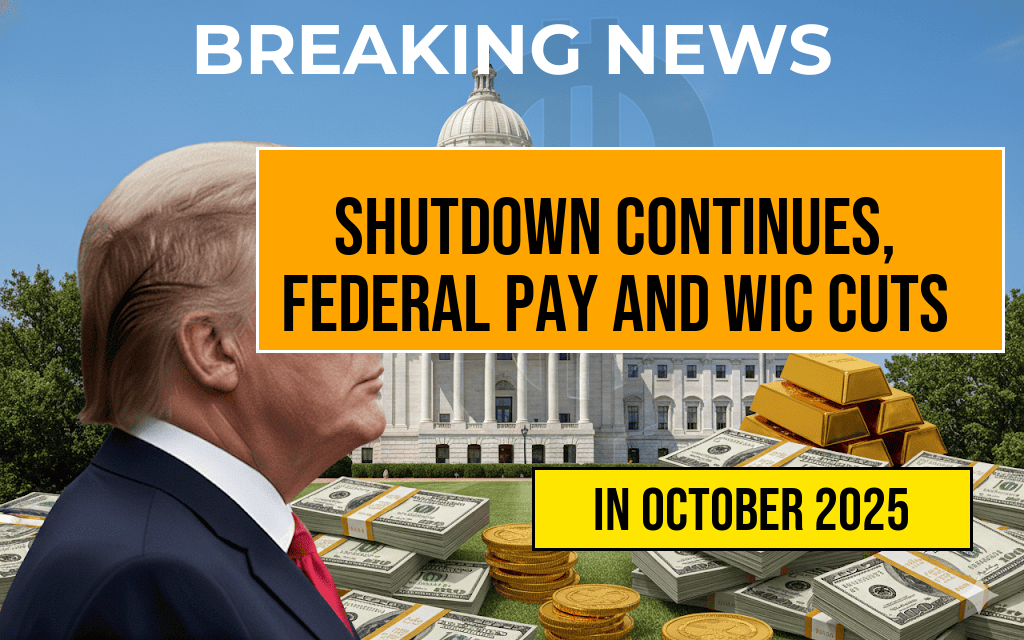Six Days Into Government Shutdown, Federal Workers Struggle Without Pay as $8 Billion WIC Program Faces Cuts
As the federal government remains shuttered for a sixth consecutive day, thousands of federal employees across the country face the reality of missing their paychecks for an extended period. Meanwhile, critical programs like the Women, Infants, and Children (WIC) nutrition assistance initiative, which has an annual budget of approximately $8 billion, are now confronting significant funding shortfalls that threaten to interrupt services for vulnerable populations. The impasse stems from unresolved budget negotiations on Capitol Hill, leaving many federal agencies operating under temporary funding measures and causing widespread uncertainty among workers and beneficiaries alike.
Federal Workers Confront Financial Uncertainty Amid Shutdown
Federal employees, including essential personnel such as law enforcement officers, air traffic controllers, and health officials, continue to serve despite the lack of pay. However, many are expressing increasing concern about their ability to meet basic expenses as the shutdown persists without a clear resolution in sight. The Office of Personnel Management reports that, since the shutdown began, approximately 800,000 federal workers have been furloughed or required to work without pay.
- Furloughed employees are temporarily laid off, missing paychecks and often facing mounting bills.
- Essential workers are required to continue working without immediate compensation, though efforts are underway to provide back pay once funding is restored.
- Some agencies have implemented financial hardship programs to assist affected workers during this period.
Economic experts note that extended shutdowns can have ripple effects beyond federal employees, impacting local economies and small businesses that rely on federal contracts or services. The Congressional Budget Office estimates that the current impasse could cost the economy billions of dollars if prolonged beyond a few weeks.
WIC Program Faces Funding Cuts Amid Political Deadlock
The Women, Infants, and Children (WIC) program, administered by the U.S. Department of Agriculture (USDA), provides essential nutrition assistance to nearly 6 million low-income pregnant women, new mothers, and young children. With an annual budget of approximately $8 billion, WIC plays a critical role in promoting healthy pregnancies and childhood development. However, due to the ongoing government shutdown, WIC’s funding is now at risk of being severely curtailed, threatening to disrupt services nationwide.
While some states have designated emergency funds or are operating on prior allocations, the program’s capacity to sustain nationwide outreach and support is waning. WIC clinics may face closures or reduced hours, limiting access for families who rely on the assistance to secure nutritious foods and health education.
| Impact Area | Description |
|---|---|
| Clinic Operations | Potential closures or reduced hours at local WIC clinics affecting service availability |
| Food Benefits | Possible delays or reductions in food benefit issuance to eligible families |
| Health Education | Limited access to nutrition counseling and health promotion activities |
USDA officials have indicated that they are working to mitigate disruptions by reallocating funds where possible, but the scope of the shutdown complicates these efforts. Advocacy groups warn that prolonged funding gaps could undermine years of progress in maternal and child health initiatives.
Political Standoff Continues Without Clear Resolution
The deadlock on Capitol Hill centers around disagreements over budget priorities and policy provisions, with neither side willing to compromise. Lawmakers have yet to reach an agreement on a funding package that can pass both chambers of Congress and be signed into law by the President. The impasse has led to the continuation of a partial government shutdown, affecting approximately 30% of federal agencies.
Senators and House members are under mounting pressure from constituents and industry stakeholders to find common ground. The Washington Post reports that negotiations are ongoing but remain fraught with ideological differences that are difficult to bridge amid tight political timelines.
Potential Consequences and Steps Forward
Experts warn that if the shutdown continues beyond a few more days, the cumulative economic costs will escalate, and the most vulnerable populations could face lasting setbacks. The uncertainty surrounding federal funding also hampers planning and operations within affected agencies and programs.
Congressional leaders have expressed hope that a bipartisan agreement can be reached soon, but no definitive timeline has been established. In the meantime, federal workers and beneficiaries are navigating a period of financial and service uncertainty that underscores the importance of swift legislative action.
Resources and Support
- Federal workers seeking assistance can visit the Office of Personnel Management website for updates.
- Families affected by potential WIC disruptions should contact their local clinics or visit the USDA’s WIC program page for guidance and support options.
- For ongoing coverage and updates on the shutdown negotiations, consult reputable sources such as NPR or CNN.
Frequently Asked Questions
What is the current status of federal workers’ pay during the shutdown?
Federal workers are currently facing No Pay as the government remains shut down after six days, impacting their ability to receive their salaries on time.
How is the WIC program affected by the shutdown?
The $8 Billion WIC Program faces significant cuts, which could reduce nutritional assistance for women, infants, and children relying on this vital support.
What are the reasons behind the government shutdown?
The shutdown is a result of ongoing budget disagreements and the failure to pass a funding bill, leading to the closure of various government services and unpaid work for federal employees.
What impact does the shutdown have on essential government services?
While some essential services continue, many non-essential programs and agencies are temporarily closed, disrupting services like nutritional programs, administrative functions, and public assistance.
Is there any plan to end the shutdown and restore funding?
Negotiations are ongoing among lawmakers to reach a funding agreement that will end the shutdown, restore pay for federal workers, and prevent further cuts to programs like WIC.

Leave a Reply